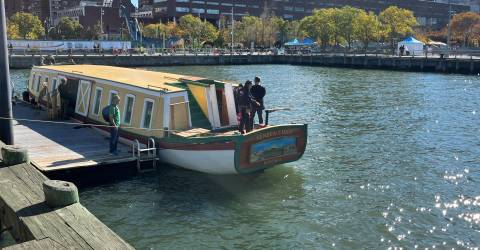October 26, 1825 was the dawn of a new era for New York and at that time, the 24-state United States when a small canal boat completed a 363 mile journey that started in the Erie Canal headed east to Albany and then south down the Hudson River south to Manhattan Island. It was a huge infrastructure project for the time and one that was marked by pomp and circumstance exactly 200 years later as a modern canal boat completed the same 363 journey to a landing in Tribeca to mark the occassion.
In the original journey, travel took a week or so with teams of four horses and alternate mule power, on the long canal and river journey; the VIP passenger (and captain) was NY State Governor DeWitt Clinton. Clinton was derided by his political opponents during the canal’s construction, and labeled it “Clinton’s Folly.” The Governor had the last laugh in 1825.
This past weekend saw the replica of the Seneca Chief, the first canal boat to traverse the Canal, which had celebrated the eight-year project’s opening. The Seneca Chief came to Manhattan, fittingly, on the 28th and last stop on a 33-day journey from Buffalo, traversing today’s slightly shorter canal route.
Gov. Hochul mentioned that The West Point Band was asked to be present at the ceremonies on October 26, as they were when the original Seneca Queen arrived in New York Harbor. Unlike 1825, she explained, the government shutdown prevented this from happening.
On Oct. 25 and 26, at Pier 26 in Lower Manhattan on West Street near Hubert Street, an opportunity was there for the public to view and tour the Buffalo Maritime Center’s delightfully handcrafted replica. While Clinton traveled on the first voyage, the current one carried enthusiastic center volunteers and staff, proud to be moving on what had been a five year construction project by hundreds of volunteers, the project envisioned by former center founder Dr. John Montague. He dreamed of the whole project a decade before 2019, when the Center received funding to build the Seneca Chief in Buffalo. It became a five-year project.
A unique inside look back across two centuries by Straus News Manhattan happened on an Upstate trip in late October to Hudson NY. There, we witnessed an arrival ceremony, and a cruise the following morning on the 73-foot long floating museum. This stop, part of the 33-day, 28-stop journey to New York City from Buffalo was propelled, not by mules or horses, but by a small 1964 tugboat, and a 16 foot push boat to help maneuver; the Seneca Chief has no engine, and the latter two provided propulsion.
After a rainy afternoon’s arrival in Hudson, the next morning’s voyage from Hudson to Kingston, took four and a half hours down the Hudson River. Under clear skies and fall foliage, the River, largely devoid of boats, showed the striking autumn foliage on both banks, neighboring hills adding a fall color palette. Aboard, museum exhibits had been tucked away for the trip inside, the midship doors open for an outstanding view of the Mid-Hudson Valley, from a slow moving boat. As it was in 1825, there were no lavatories or creature comforts on board, just the three boats, nestled together, traveling downriver at five knots.
And in Manhattan, as it has been with the 27 previous stops, the Chief displayed recreated cabins, historical artifacts, and interactive exhibits highlighting the canal’s cultural, economic, and environmental significance.
To herald the anniversary, Gov. Hochul and other speakers addressed invited guests at the welcoming ceremony. Held at Pier 25 in TriBeCa, the Governor was introduced by DeWitt Silber, who was Gov. DeWitt Clinton’s 15-year-old great-great-great-great-great-grandson.
As a native Buffalonian, Hochul’s interest in the project was almost proprietary; she mentioned watching the building of the Seneca Chief in Canalside Buffalo, five minutes from her house. She remarked that it took the work of hundreds of volunteers during the building from 2020 to 2024. The Governor spoke of the history-making event’s impact on the United States, especially New York;
“Too big, too hard, too daunting? We have that spirit, we always did.” she noted.
Continuing, she explained how the 1848 Seneca Falls, NY Conference on Women’s Rights came about; the Erie Canal made it easier for people to come there from points along the Canal and the Hudson River. The Governor mentioned that it was important to note the suffering of Native Americans, who lost their lands when the Erie Canal was built. She said it was important to remember their loss.
As a memorialization, an Eastern White Pine tree was planted on Pier 25, echoing the 1825 “Wedding of the Waters” tradition. Each port of call added local canal water to the traveling cask aboard the Seneca Chief, that water used to nurture the tree in New York City, symbolically uniting New York State.
Fittingly, the recessional music on the PA system? ”Low Bridge, Everybody Down” a 1912 song covered by Bruce Springsteen, written about the first 55 years of the Erie Canal.
For further information please consult www.buffalomaritimecenter.org

